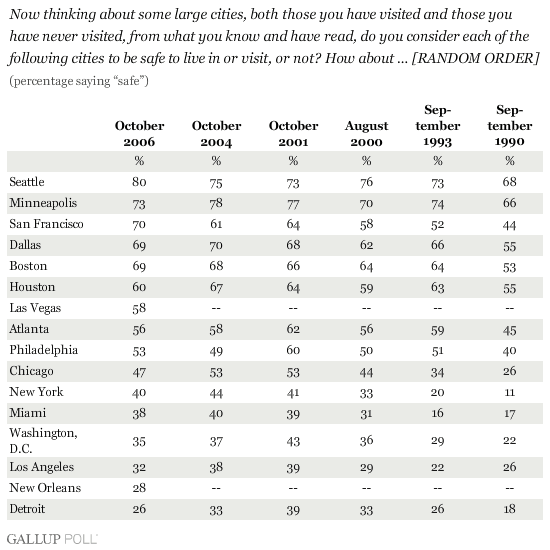PRINCETON, NJ -- Media outlets over the weekend carried reports of a new study published by a private research group that named Detroit as the most dangerous U.S. city. The study was based on an analysis of FBI crime data carried out by CQ Press, a unit of Congressional Quarterly Inc. According to an Associated Press report, the study has been harshly criticized by Detroit city officials and other groups that question its methodology and use of data.
The CQ Press study was based on per-capita rates for the incidence of various crimes, which were in turn weighted on the basis of their seriousness. The most dangerous cities according to the study were Detroit; St. Louis; Flint, Mich.; Oakland, Calif.; Camden, N.J.; Birmingham, Ala.; North Charleston, S.C.; and Memphis, Tenn.
According to the AP, the FBI itself criticized the ratings, saying on its Web site that "these rough rankings provide no insight into the numerous variables that mold crime in a particular town, city, county, state, or region."
The debate makes it clear that there is no easily agreed-upon way to determine exactly which city or region is the most dangerous, or the safest. In recent years, The Gallup Poll has contributed its own public opinion data to the mix of ways in which cities can be ranked, based on the results of a question that asks Americans their views of whether a list of cities in the United States are safe to live in or visit.
The results of the latest such rankings, from October 2006, show that in the court of public opinion, the American people seem to agree with the recent analysis of FBI statistics: Detroit is viewed as the least safe of any of the 16 major cities rated.

Twenty-six percent of Americans in the October 2006 poll rated Detroit as safe to live in or visit, giving the Motor City technically the lowest ranking of the survey -- although it was just a few points below New Orleans and Los Angeles. Detroit has consistently ranked as one of the least safe cities in the public's eyes when Gallup has asked this question. At the other end of the scale, Seattle had the highest "safe" percentage in these rankings in 2006.
It is likely that many respondents in the Gallup survey had never visited many of the cities whose perceived safeness they were asked to rate, meaning that the ratings were based on news media accounts and hearsay from friends and relatives.
Still, a basic principle of social psychology says that if an individual perceives a situation as real, the consequences are real. Thus, the perceptions from afar of the safeness of these cities may influence the probability of visiting them for future pleasure or business. This of course reinforces the concerns of leaders in the cities ranking near the bottom of the controversial CQ Press ratings, who fear that bad publicity could in turn affect real-world behavior.
Survey Methods
These results are based on telephone interviews with a randomly selected national sample of 1,001 adults, aged 18 and older, conducted Oct. 9-12, 2006. For results based on this sample, one can say with 95% confidence that the maximum error attributable to sampling and other random effects is ±3 percentage points. In addition to sampling error, question wording and practical difficulties in conducting surveys can introduce error or bias into the findings of public opinion polls.
